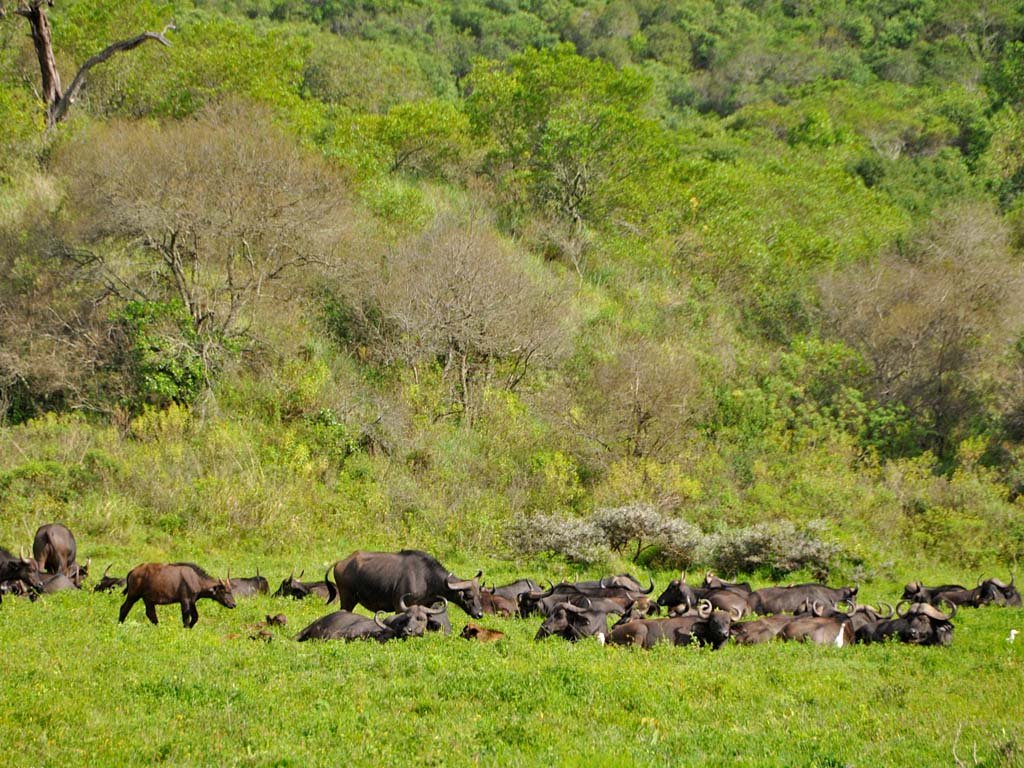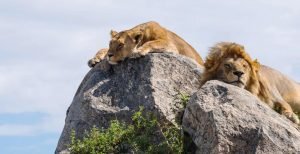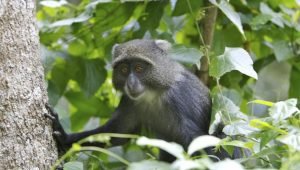
Arusha National Park
The closest national park to Arusha town – northern Tanzania’s safari capital – Arusha National Park is a multi-faceted jewel, often overlooked by safarigoers, despite offering the opportunity to explore a beguiling diversity of habitats within a few hours.

The entrance gate leads into shadowy montane forest inhabited by inquisitive blue monkeys and colourful turacos and trogons – the only place on the northern safari circuit where the acrobatic black-and-white colobus monkey is easily seen. In the midst of the forest stands the spectacular Ngurdoto Crater, whose steep, rocky cliffs enclose a wide marshy floor dotted with herds of buffalo and warthog.

Further north, rolling grassy hills enclose the tranquil beauty of the Momela Lakes, each one a different hue of green or blue. Their shallows sometimes tinged pink with thousands of flamingos, the lakes support a rich selection of resident and migrant waterfowl, and shaggy waterbucks display their large lyre-shaped horns on the watery fringes. Giraffes glide across the grassy hills, between grazing zebra herds, while pairs of wide-eyed dik-dik dart into scrubby bush like overgrown hares on spindly legs.
Although elephants are uncommon in Arusha National Park, and lions absent altogether, leopards and spotted hyenas may be seen slinking around in the early morning and late afternoon. It is also at dusk and dawn that the veil of cloud on the eastern horizon is most likely to clear, revealing the majestic snow-capped peaks of Kilimanjaro, only 50km (30 miles) distant.
But it is Kilimanjaro’s unassuming cousin, Mount Meru – the fifth highest in Africa at 4,566 metres (14,990 feet) – that dominates the park’s horizon. Its peaks and eastern footslopes protected within the national park, Meru offers unparalleled views of its famous neighbour, while also forming a rewarding hiking destination in its own right.

Passing first through wooded savannah where buffalos and giraffes are frequently encountered, the ascent of Meru leads into forests aflame with red-hot pokers and dripping with Spanish moss, before reaching high open heath spiked with giant lobelias. Everlasting flowers cling to the alpine desert, as delicately-hoofed klipspringers mark the hike’s progress. Astride the craggy summit, Kilimanjaro stands unveiled, blushing in the sunrise.
MORE HIGHLIGHTS
The transition between unappealing urban chaos and pristine mountain hiking trails is rarely as abrupt as it is in Arusha National Park. One of Tanzania’s most beautiful and topographically varied protected areas, the park is dominated by Mt Meru, an almost perfect volcanic cone with a spectacular crater.
It also shelters Ngurdoto Crater (often dubbed Little Ngorongoro), with its swamp-filled floor and lost-world feel.
At 552 sq km, it’s a small park and, while there is wildlife here, it’s nothing compared to that of other northern-circuit parks. But these minor details can be quickly forgotten when you’re walking amid the soul-stirring scenery and exploring the meaningful trekking possibilities.
Arusha National Park is the ‘odd one out’ in Tanzania’s northern safari circuit. It doesn’t offer the usual range of wildlife that the other parks do. Of the Big Five, only buffalo are regularly seen, and lion and rhino are absent. Its appeal lies in the scenic beauty and unusual animals. The charismatic black-and-white colobus monkey is the flagship species.
It’s well known for Game drives, walking safaris, canoe safaris, picnicking, and climbing Mt. Meru. Also walking and canoe safaris which make it day trip ideally destination.
Wildlife Highlights
The forest in Arusha National Park is home to species not often encountered in other parks in northern Tanzania, including blue monkey and black-and-white colobus. If you are lucky, you might also spot a shy red duiker. More common is the even smaller Kirk’s dik-dik. Giraffe are very common in the area around the Momella lakes.Kirk’s dik-dik.
With diverse wildlife that includes herbivores such as elephants, hippos, buffalo, zebra, and even the occasional wildebeest, Arusha National Park is also a perfect place to get out and stretch your legs – with both walking safaris and canoe safaris available within the park.

Arusha National Park is also home to the world’s largest population of giraffes, making it a great place to visit for fans of these long-necked, beautiful animals.
Arusha National Park boasts a broad variety of landscapes, ranging from open savannah through acacia scrubland to rainforest and, eventually, to alpine conditions on the higher reaches of Mt. Meru.
Outstanding Wildlife Diversity
Due to the varied landscapes that exist within the park, there is an unusually high level of diversity when it comes to wildlife.
Not only is the park home to Africa’s largest giraffe population, but visitors can also expect to see water bucks, cape buffalo, elephants, blue monkeys, black and white colobus monkeys, turacos, trogons, and even the occasional lion or leopard in the right conditions.
The park also boasts an incredibly diverse variety of bird-life, making it a popular stop for birding enthusiasts.
Africa’s fifth highest mountain cuts a striking figure at 4,566m (14,990 feet). While Kilimanjaro is often shy and hides behind clouds, Mt. Meru is generally visible throughout the year.
An active volcano, Mt. Meru is also a popular climbing destination for visitors to Tanzania and a good introductory mountain for those wishing to climb Kilimanjaro. Not only does the climb offer a spectacular view of Kilimanjaro from the summit, but the hike itself is also an incredibly rewarding walking safari that takes you through multiple habitats where you can encounter giraffes, elephants, antelopes, and more
For those interested in climbing Mt. Meru, Shadows of Africa can arrange climbing permits, armed ranger escorts, all camping equipment, and even stays at the Miriakamba or Saddle Huts if necessary.
The Momella Lakes within Arusha National Park are a series of seven shallow lakes: Big Momella, Small Momella, Kusare, Lekandiro, Tulusia, Rishateni, and El Kekhotoito. Alkaline lakes with considerable algae growth, each of these lakes is a different shade of green or blue.
While the water is not suitable for drinking, it is possible to see a variety of birds (including flamingoes) and animals such as water bucks, giraffes, zebras, and dik-diks in the surrounding area. It is on Small Momella Lake that canoeing safaris are possible.
This swampy crater is inhabited by a large variety of animals and is a popular stop for game drives. Visitors can expect to see the Cape Buffalo, elephants, monkeys, baboons, warthogs, and a number of different antelope species here.
The crater is surrounded by the Ngurdoto Forest, a shady expanse that is home to playful black and white colobus monkeys.
Nearby is Serengeti Ndogu (Little Serengeti), an expansive grassland where herds of zebras can be seen throughout the year.
Overlooking the Ngurdoto Forest with its population of black and white colobus monkeys, the Ngurdoto Museum houses an impressive collection of examples of the various animals, birds, and insects that can be found within the park.
The only freshwater lake in Arusha National Park, Lake Longil is a popular watering hole for buffaloes and water bucks.
A former lookout point during tribal wars from Tanzania’s post, Tululusia Hill is today a popular hiking and camping area that affords visitors an excellent view of the lower reaches of the Arusha National Park as well as Mount Kilimanjaro and Mount Meru.
This heavily forested region of the park is home to elephants, buffalo, colobus monkeys, the red duiker, suni, leopards, and even tree-dwelling pythons.

Fig Tree Arch
A distinctive natural arch formed by a fig tree, this intriguing feature of the landscape has grown into an arch large enough for a car or an elephant to pass under.
This is a Fig tree (Ficus thonningii) whose roots have grown to take the shape of an arch, large enough for a car (elephant size) to pass underneath. It was formed when seeds of the parasitic tree were dropped by foraging birds in the fork of a host tree, allowing germination to take place and the tree’s roots to slowly reach the ground thereby strangling its host.
















